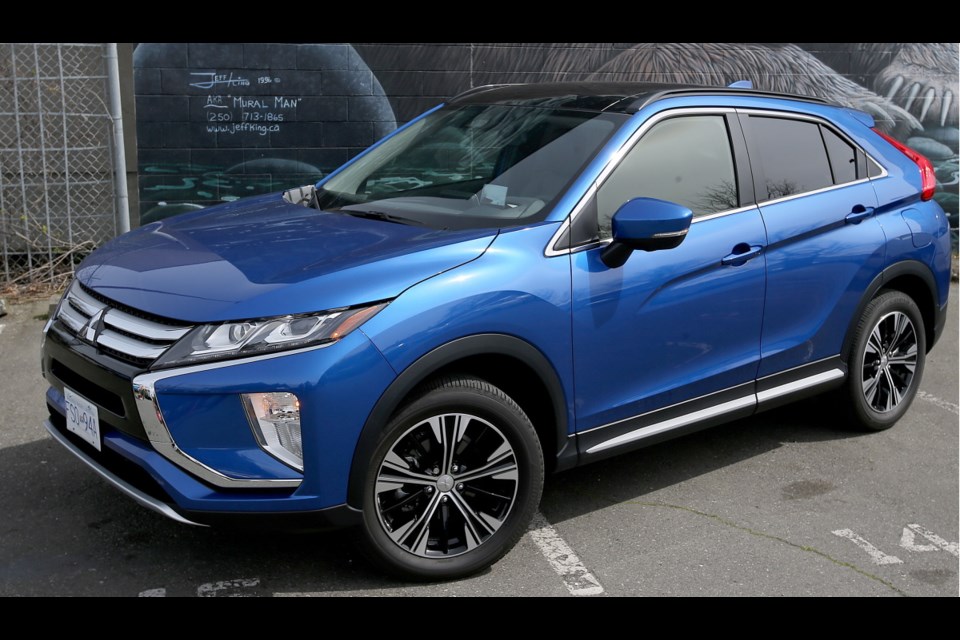Goldilocks must have been on the minds of Mitsubishi designers and marketers as they created the 2018 Eclipse Cross.
In the famous fairy tale, Goldilocks sampled some porridge, sat on three chairs and picked out one of three beds.
The 2018 Eclipse Cross is an entirely new SUV/crossover for Mitsubishi, sitting right in the middle between the slightly larger Outlander and the slightly smaller RVR.
I drove a GT model, with a manufacturer’s suggested retail price of $35,998.
While where it sits in the Mitsubishi line is clear, its position in comparison with the competition is a lot less so. I would call the Eclipse Cross more of a tweener, sitting between two defined segments — the compact and subcompact SUV/crossover groups.
That gives the new vehicle a bevy of potential rivals — vehicles such as the Honda CR-V and Toyota RAV 4 on one compact side and the Mazda CX-3 and Nissan Qashqai on the other, just to name a few.
As in the fairy tale, a hands-on comparison is the best strategy.
At a base price of $27,798, the Eclipse Cross is priced higher than its competitors. Mitsubishi chose not to offer a no-frills model, equipping even their least-expensive offering with standard all-wheel drive (cost-cutting competitors’ base-model vehicles only have front-wheel drive).
Instead of making buyers pay more for an upgraded, more fuel-efficient engine, Mitsubishi equips all Eclipse Crosses with a turbocharged 1.5-litre four-cylinder engine producing 152 horsepower and 184 foot-pounds of torque.
The 152 horsepower is, as suspected, roughly smack in the middle between the Outlander and RVR. But the torque is a big surprise. It actually delivers more oomph than both the Outlander and the Honda CR-V, which produces only 179 lb.-ft. of torque.
People who travel on less-than-perfect terrain will appreciate Mitsubishi’s Super All-Wheel Control system. In addition to appropriating power to the front and rear wheels, the system can also distribute power as needed between the left and right wheels, as well.
All Eclipse Crosses come equipped with a continuously variable transmission. Mitsubishi has included a Sport mode, where drivers can call up eight virtual gears.
Driven gently, the transmission virtually disappears into the background in Drive mode. But if you put the pedal to the metal in Drive, the CVT gives out a moan (a common trait among the breed) as the transmission frantically tries to match engine speed to throttle input.
The way around this is to revert to Sport mode, when the driver can dictate which gear to use.
The Eclipse Cross is not meant as a replacement for a sports sedan, but, by using the steering-wheel mounted paddles to shift gears in manual mode, it can be entertaining.
The Eclipse Cross shares the same platform — and the same wheelbase — as the larger Outlander, so the ride is superior to the subcompact SUV field. It boasts a compliant ride on paved roads and is not unsettled by less-than-perfect road conditions.
The hours spent refining the body in wind tunnels are evident, as the Eclipse Cross quietly slices through the air at highway speeds.
The cabin is well thought out, with clear lines of sight and logical placement of controls. My car had a trackpad instead of a knob to point to different controls on the seven-inch infotainment screen (which is also a touchscreen). What is appreciated is that the most commonly used controls are physical and not hidden under layers of menus and sub-menus.
My tester had a heads-up display, which my wife found distracting. A simple push of a button, and the system retracts into the top of the instrument cluster.
One notable feature in our car’s multi-view camera system was one camera focused on the right front wheel — a nice aid when parking against a curb (or if you were climbing on rocks).
The top models comes equipped with a comprehensive safety suite that includes forward collision mitigation, lane-change assist, lane-departure warning, rear cross-traffic alert and blind-spot warning.
A generous back seat cuts into available cargo capacity — 626 litres with the seats up and 1,382 when down. Mitsubishi gives owners control on the ratio appropriated between the two, with seat backs that can recline from 16 to 32 degrees. The seat bottoms (which come heated in the top model) can also slide 200 mm forward and back.
My tester was equipped with a two sunroofs, with the forward one able to open. While the rear glass is fixed, the back seat occupants could engage or retract a power sun screen, a nice touch not usually found in this segment.
If you like your music loud, you will appreciate the 710-watt nine-speaker Rockford-Fosgate audio system.
Unlike Goldilocks, I did not try to sleep in the vehicle.
Not too large, not too small, the Eclipse Cross makes for a fairy-tale ending for SUV/crossover buyers.
THE SPEC SHEET
Type: Compact SUV/Crossover, front engine, all-wheel-drive
Engine: Turbocharged 1.5-litre four-cylinder, 152 hp at 5,500 r.p.m., 184 lb.-ft. of torque at 2,000 to 3,500 r.p.m.
Transmission: CVT with eight virtual gears
Dimensions (mm): Length, 4,405; width, 1,805; height, 1,690; wheelbase, 2,670
Curb weight (kg): 1,590
Price (base/as tested): $35,998/$37,798 (includes $1,700 freight and PDI and $100 AC tax)
Options: Nil
Tires: 225/55 R 18 on alloy wheels
Fuel type: Regular
Fuel economy (L/100km): 9.6 city/ 8.9 highway
Warranty: Five years/100,000 km new car, 10 years/160,000 km powertrain and Five years/ unlimited km roadside assistance



